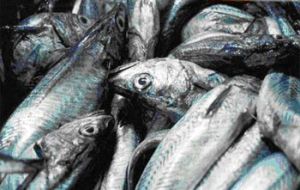MercoPress. South Atlantic News Agency
Argentine hake fishery and markets at risk because of over-fishing, says NGO
 Eighty per cent of adult hake have disappeared from the Argentine sea as a result of overfishing, FVSA states.
Eighty per cent of adult hake have disappeared from the Argentine sea as a result of overfishing, FVSA states. Argentina could lose 40% of its fish market if hake (Merluccius hubbsi) captures do not follow new requirements imposed by the European Union (EU) to import fish and shellfish, warned the Wild Life Foundation Argentina, (FVSA).
The non government organization is demanding the “immediate implementation of measures that prevent the capture of juveniles and a 30% reduction in total allowable catch, TAC for 2010.”
According to FVSA data, 80% of adult hake have disappeared from the Argentine sea as a result of over-fishing and juvenile catches, as detailed in its report: “Year 10; Hake 0”.
According to the group, two measures are at stake this year that could worsen the state of Argentina’s main seafood resource.
On the one hand, the Federal Fisheries Council, CFP, approved the possibility of fishing 30% more than recommendations to spur the resource’s recovery. In addition, in February 2009 it suspended the use of the selective fishing device (DEJUPA) for juvenile catches.
“At the beginning of 2010, Wild Life filed a request for reports before the CFP and asked for corrections to both measures. Nevertheless, in spite of the corresponding deadlines, it has not yet received a response to its petition from the authorities,” added the entity in an official statement.
”The hake, because of its characteristics, will not be extinguished, but it will reach such low numbers that it will become unprofitable to go out and fish it,” the statement read.
FVSA director, Diego Moreno said “the first to suffer the full impact of insufficient hake are the companies and the fishermen”. Moreno also recalled that the fisheries sector in Argentina generates close to a billion US dollars in exports and employs directly, 20.000 people.
“Argentina needs a sensible and sustainable fishing model, one that comprehends that economic, social, political and environmental dimensions go hand in hand. The fish, fishing and the fishers must be protected as a whole” Moreno explained.
“It doesn’t turn out sustainable to fish more hake than what is renewed every year, as is happening at the moment. Nor is it rational to allow the indiscriminate catch of fish that have not yet achieved their first reproduction”, said Moreno who added that Argentina’s constitution, Environment legislation and the Federal Fisheries Regime, clearly sets out that the exploitation of natural resources must be rational and compatible with their conservation. For that reason, we contend that hake fishing, under the present conditions, could be in non compliance of the law.”
”This puts the whole fishing activity in a high-risk situation before markets such as the European Union, ever more demanding as far as the sustainability of the products it imports,” Moreno said.
Argentina’s common hake TAC for his year was established by CFP at 338.000 tons. This surpasses 2009’s TAC by 72,000 tons, or 27%.
According to statistics from the Fisheries and Aquaculture Sub-Secretariat, 34,372.8 tons of hake were landed in Argentine ports between January first and March 18, which is 4.1% less than between the first day of 2009 and 28 February of that year when 35,829.9 tons were landed.
Of total landings this year, 34,003.2 tons were fished to the south of parallel 41º and the rest, 369.6 tonnes, to the north of the same.




Top Comments
Disclaimer & comment rulesCommenting for this story is now closed.
If you have a Facebook account, become a fan and comment on our Facebook Page!